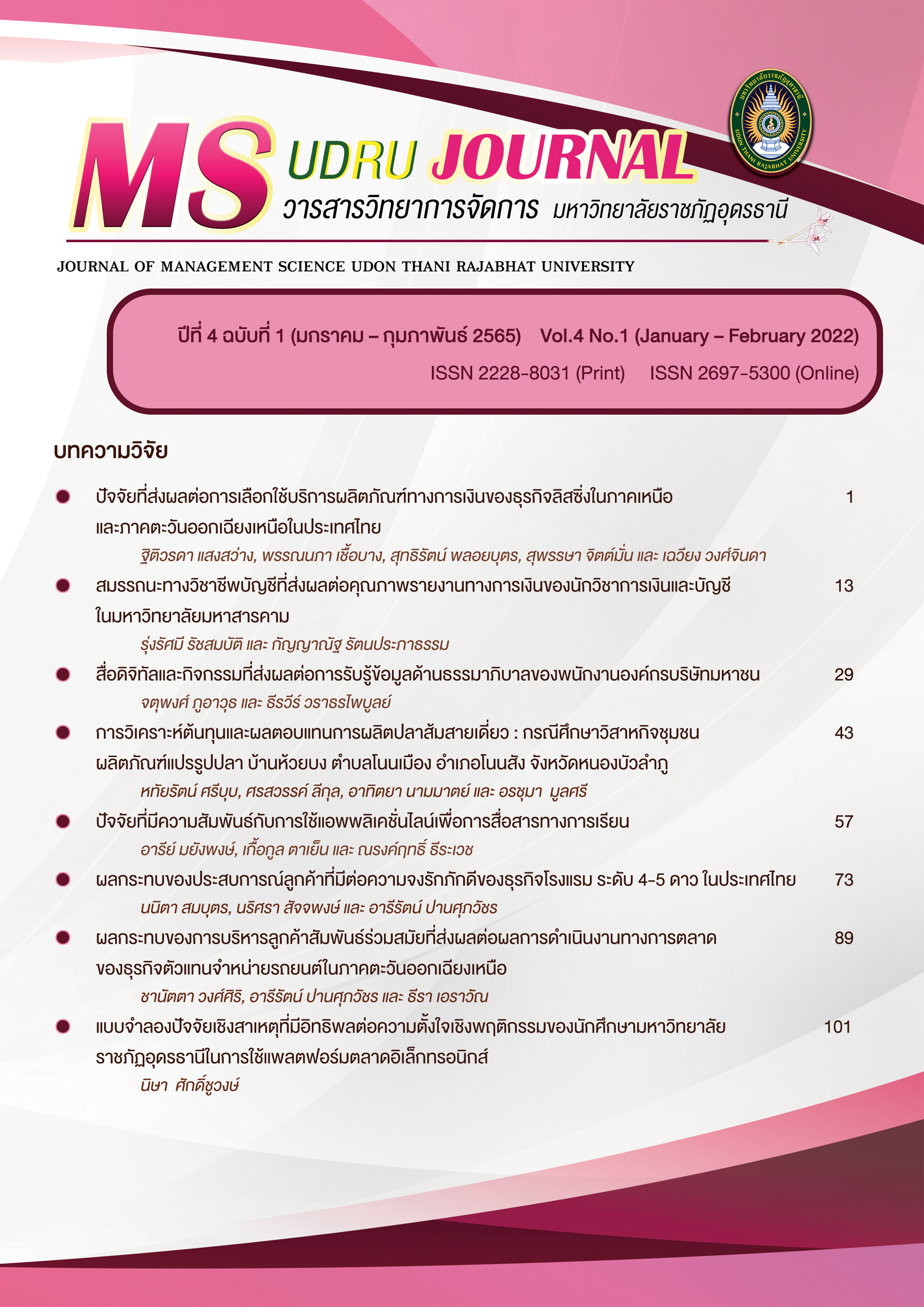ปัจจัยที่ส่งผลต่อการเลือกใช้บริการผลิตภัณฑ์ทางการเงินของธุรกิจลิสซิ่งในภาคเหนือและภาคตะวันออกเฉียงเหนือในประเทศไทย
Main Article Content
บทคัดย่อ
วิจัยมีวัตถุประสงค์เพื่อศึกษาปัจจัยที่ส่งผลต่อการเลือกใช้บริการผลิตภัณฑ์ทางการเงินของธุรกิจลิสซิ่งในภาคเหนือและภาคตะวันออกเฉียงเหนือในประเทศไทย และเพื่อเปรียบเทียบปัจจัยที่ส่งผลกระทบต่อการเลือกใช้บริการผลิตภัณฑ์ทางการเงิน จำแนกตามเพศ และรายได้เฉลี่ยต่อเดือนกลุ่มตัวอย่าง คือ ผู้ใช้บริการธุรกิจลิสซิ่ง จำนวน 400 คน เก็บข้อมูลโดยใช้แบบสอบถามมีผู้ตอบกลับคืนมา จำนวน 386 คน คิดเป็นอัตราตอบกลับ ร้อยละ 96.50 วิเคราะห์ข้อมูลโดยใช้สถิติการแจกแจงความถี่ ค่าร้อยละ ค่าเฉลี่ย ส่วนเบี่ยงเบนมาตรฐาน การทดสอบที และการทดสอบเอฟ ผลการวิจัยพบว่า ปัจจัยที่ส่งผลต่อการเลือกใช้บริการผลิตภัณฑ์ทางการเงิน ประกอบด้วย ปัจจัยด้านการรับรู้ ภาพลักษณ์ คุณภาพการให้บริการ กระบวนการ ความยุติธรรม ความสะดวกสบาย เทคโนโลยีทางการเงิน และส่วนประสมการตลาด ได้แก่ ผลิตภัณฑ์ ราคา ช่องทางการจัดจำหน่าย การส่งเสริมการตลาด พนักงาน ลักษณะทางกายภาพ การให้ข่าวสาร และพลัง ส่งผลต่อการเลือกใช้บริการของผู้ใช้บริการในระดับมาก นอกจากนี้เพศแตกต่างกันส่งผลต่อการเลือกใช้ผลิตภัณฑ์ทางการเงินด้านภาพลักษณ์แตกต่างกัน รวมถึงรายได้เฉลี่ยต่อเดือนที่แตกต่างกันอีกด้วย
Article Details

อนุญาตภายใต้เงื่อนไข Creative Commons Attribution-NonCommercial-NoDerivatives 4.0 International License.
บทความที่ได้รับการตีพิมพ์เป็นลิขสิทธิ์ของคณะวิทยาการจัดการ มหาวิทยาลัยราชภัฏอุดรธานี
ข้อความที่ปรากฏในบทความแต่ละเรื่องในวารสารวิชาการเล่มนี้
ไม่ใช่ความคิดเห็นและความรับผิดชอบของผู้จัดทำ บรรณาธิการ กองบรรณาธิการ และคณะวิทยาการจัดการ มหาวิทยาลัยราชภัฏอุดรธานี ความรับผิดชอบด้านเนื้อหาและการตรวจร่างบทความแต่ละเรื่องเป็นความคิดเห็นของผู้เขียนบทความแต่ละท่าน
เอกสารอ้างอิง
กรมพัฒนาธุรกิจการค้า. (2560). ข้อมูลผู้ใช้บริการธุรกิจลิสซิ่งในภาคเหนือและภาคตะวันออกเฉียงเหนือ. สืบค้นเมื่อ 7 เมษายน 2560, จาก https://www.dbd.go.th
กิติ ผสมทรัพย์. (2551). การศึกษาความคิดเห็นเกี่ยวกับปัจจัยที่มีผลต่อการเลือกใช้สินเชื่อเช่าซื้อรถยนต์จากธุรกิจลิสซิ่งในจังหวัดเชียงใหม่. วิทยานิพนธ์บริหารธุรกิจมหาบัณฑิต สาขาบริหารธุรกิจ มหาวิทยาลัยเชียงใหม่.
ทันดร ธนะกูลบริภัณฑ์. (2552). คู่มือจัดองค์ความรู้ มาตรฐานการให้บริการ. สำนักการศึกษาต่อเนื่อง. นนทบุรี: มหาวิทยาลัยสุโขทัยธรรมาธิราช.
บุญชม ศรีสะอาด. (2545). การวิจัยเบื้องต้น. พิมพ์ครั้งที่ 7. กรุงเทพมหานคร: สุวีริยาสาส์น.
พรชัย ชุณหจินดา. (2560). ฟินเทคเพื่อก้าวสู่การเป็นประเทศไทย 4.0. สืบค้นเมื่อ 24 ตุลาคม 2560, จาก http://e-jodil.stou.th.
พัชราภรณ์ เกษะประกร. (2558). กลยุทธ์การประชาสัมพันธ์เพื่อการบริหารเอกลักษณ์ ภาพลักษณ์ และชื่อเสียงองค์กร. กรุงเทพมหานคร: มหาวิทยาลัยกรุงเทพ.
มหาวิทยาลัยสุโขทัยธรรมาธิราช. (2539). เอกสารการสอนชุดจิตวิทยาการบริการ. พิมพ์ครั้งที่ 3 นนทบุรี: มหาวิทยาลัยสุโขทัยธรรมาธิราช สาขาวิชาคหกรรมศาสตร์.
รุจินันท์ เอื้อพิทักษ์สกุล วิราพร โชติปัญญา และณัฐวุฒิ สมยาโรน. (2564). กลยุทธ์การสื่อสารการตลาดที่มีอิทธิพลต่อการตัดสินใจซื้อเครื่องสำอางของผู้ขายในประเทศไทย. วารสารวิทยาการจัดการ มหาวิทยาลัยราชภัฏอุดรธานี. 3(1). 49-66.
วิทวัส รุ่งเรืองผล. (2552). หลักการตลาด. พิมพ์ครั้งที่ 5. กรุงเทพมหานคร: มาร์เก็ตติ้งมูฟ.
ศิริวรรณ เสรีรัตน์ ปริญ ลักษิตานนท์ และศุภกร เสรีรัตน์. (2552). การบริหารการตลาดยุคใหม่ฉบับปรับปรุงใหม่. กรุงเทพมหานคร: ธรรมสาร.
สมคิด ยาเคน และพรรณเพ็ญ หอมบุญมา. (2559). ปัจจัยการเลือกใช้บริการทางการเงินจากธนาคารออมสินของประชากรในเขตเมืองและนอกเมืองจังหวัดลำปาง. วารสารบริหารธุรกิจ เศรษฐศาสตร์และการสื่อสาร. 11(2), 160-171.
Assael, H. (1998). Consumer Behavior and Marketing Action. Ohio: South-Western College.
Cochran, W.G. (1953). Sampling Techniques. New York : John Wiley & Sons.
Lovett, H.T. (2002). The Effect of Violating the Assumption of Equal Item Means in Estimation the Livingstone Coefficient. Education and Psychological Measurement. 38(1978), 239 – 251.
Kotler, P., Hermawa, K., & Iwa, S. (2016). Marketing 4.0: Moving from Traditional to Digital. Marketing Management. New Jersey: John Wiley & Sons.


